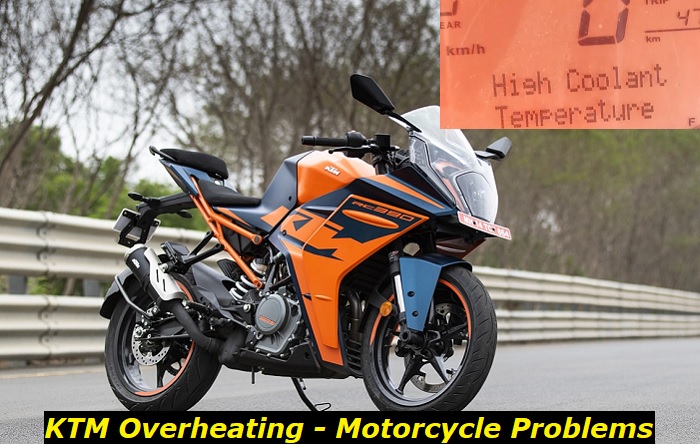KTM bikes market themselves with their proven track record in the 200 to 400 cc range. These are great commuter rides and recreation. The strategic pricing of KTM's various models and matching them with high levels of performance and durability also make them a popular choice for people who are looking for the best value for their money when it comes to motorcycles.
One major hiccup experienced by many owners of KTM bikes though has something to do with overheating. As we all know, overheating in a vehicle is always a sign of bad things coming up. So, in this article, we will try to trace the reasons for this when it comes to KTM motorcycles and we'll show you ways on how you can deal with them.

Overheating in a KTM Bike
Overheating in a KTM bike can be characterized as temperatures that exceed the normal operating range of the engine, resulting in a decrease in performance and potentially causing damage.
The most common sign of an overheated engine is when it begins to run at higher than normal temperatures or begins to emit smoke from the exhaust system. If left unchecked, this kind of heat-related damage can cause serious problems with your KTM bike, such as decreased fuel efficiency, reduced power output, and even complete engine failure.
In extreme cases, if not addressed quickly enough, an overheated engine could even suffer catastrophic damage resulting in permanent loss of function.
It is important to take steps to prevent overheating conditions on your KTM motorcycle before they start. Regular maintenance, such as checking and replacing fluids and filters, can go a long way in preventing engine heat-related problems. Keeping an eye on the temperature gauge is also essential, so if temperatures begin to rise for any reason take action immediately to ensure your KTM bike does not sustain any permanent damage from overheating.
The best course of action when dealing with an overheated engine is to stop the vehicle immediately and let it cool down completely before continuing use. Doing this will allow you to avoid further damage that could result from continued operation while the engine is too hot, thus, ensuring your KTM bike has a long life of reliable performance.
If the problem persists or turns out to be a recurring matter, we highly advise bringing your ride to your mechanic or KTM dealership for repairs.
Most Common Reasons for Overheating in KTM Bikes
There are many factors that can drive up the temperature of a motorcycle dramatically. Here are the reasons most commonly identified with KTM bikes:
1. Very High Compression Ratio
KTM bikes are known for their high compression ratio (CR). An example of this is the Duke 390 which has a CR of 12.6:1. Even the 200 Duke boasts a CR of 11.3:1.
A high CR brings plenty of advantages to an engine. This mainly translates to more power produced for a given displacement and for a given amount of fuel. This is due to the fact that a fuel mixture will burn and expand more completely the more it is compressed.
On the other side of the fence, this can also prove to be detrimental to an engine in the long run because of the high amount of heat that it tends to produce. Therefore, it is important for a vehicle, especially a motorcycle, to have measures to mitigate the temperature produced by this factor.
This issue comes with the design of the KTM bike, but that does not necessarily mean that there's nothing you can do about it. Ways to maintain its ideal operating temperatures include the following:
a. Installing an Aftermarket Radiator
Installing a radiator with a higher cooling capacity can help reduce the engine temperature by keeping the engine coolant at an ideal operating temperature. This will also ensure that your bike does not overheat and break down due to increased temperatures in the long run.
b. Upgrading the Oil Capacity
Increasing oil capacity, or using thicker oil, can help reduce heat transfer from the combustion chambers of the engine and allow it to function more efficiently while reducing heat build-up.
c. Re-tuning Your ECU
Re-tuning your ECU is another great way to address this issue as it allows you to adjust fuel delivery accordingly which helps lower combustion chamber temperatures and increases power output.
d. Installation of a Fan Kit
Installing a fan kit to your radiator can help push the hot air out of the engine compartment and keep temperatures stable.
e. Updating the Cooling Jetting Settings
Changing cooling jetting can also help reduce temperatures by controlling the flow of coolant over the hottest areas of the engine, helping to cool it down faster.
f. Calibrating the Intake Valves
Changing the intake valve's opening and closing during the pre-compression stroke is an option if you know your basics around an engine. By delaying the intake valve's closure during the compression stroke, the compression ratio is decreased while decreasing the suction volume and allowing the piston to reach the top dead center (TDC) without building up internal pressure for a predetermined amount of the stroke.
g. Applying a Thicker Gasket
One more strategy is to make the gasket thicker in order to raise the suction volume, which reduces the compression ratio. However, this may require additional modifications along the way.
KTM bikes are known for their high combustion ratio which gives them plenty of advantages but also leads to overheating issues due to the heat that is produced. This issue can be addressed with any combination or all of these measures, depending on how seriously you want to take it. Implementing these solutions can not only improve performance but may prolong the life of your bike.
2. Worn Head Gasket
High operating temperatures in the engine can contribute to the quick wear of the head gasket. Likewise, a blown head gasket can further add to the overheating problem in KTM bikes. This can also lead to problems like excessive exhaust smoke, loss of compression, and contaminated oil.
When diagnosing a blown head gasket in a KTM motorcycle it is important to check for signs that include white or gray-colored smoke coming out of the exhaust. The smoke most likely will contain both water vapor and combustion gases, which indicates a poor seal between the piston crown and cylinder head. This is usually caused by either a warped cylinder head or damaged threads on either side of the gasket. A compression test should also be done to further confirm this problem.
Inspecting for coolant leakage is another way to diagnose a blown head gasket in a KTM bike. Look around the cylinder block seams, radiator hose connections, and the base of the cylinder head. These are the most common areas coolant would leak from if there is a head gasket failure. Additionally, check for any abnormal engine noises and ensure that the oil dipstick is clean when checking it.
The best solution to this problem is to replace the faulty head gasket with a new one. Make sure to use an OEM replacement as it will be designed for optimal performance and longevity in KTM motorcycles. This should fix any issues caused by a blown or worn head gasket. If still necessary, resurface or machine the cylinder heads to remove any warps after replacing the old gasket with a new one.
Afterward, fill up the radiator with fresh coolant and check the coolant level in the reservoir regularly. When replacing a head gasket, also replace any other damaged components and inspect for any other problems that could have caused a blown head gasket. Taking all of these steps will help diagnose and fix any issues related to worn and blown head gaskets in KTM motorcycles.
3. Carbon Build-Up
Carbon build-up is fairly common to KTM bikes as they age because of the way that some of its key components are exposed to the mercy of mother nature. These can be made worse by bad maintenance habits. Ultimately, this can result in engine overheating.
If the deposits are mild and not causing any engine performance issues, they can likely be cleaned using basic cleaning techniques such as using carburetor cleaner or fuel system cleaner. For heavier build-ups, however, more extreme measures may need to be taken such as disassembling parts and physically scrubbing or scraping away at the deposits with tools like wire brushes or dental picks. If a part has been heavily damaged due to corrosion caused by carbon buildup, it will likely need to be replaced in order for full performance to be restored.
When performing the cleaning procedures, it is important to make sure that all the pieces and parts are thoroughly cleaned and free of debris before reassembly. Additionally, any gaskets or seals should be checked for wear and replaced if necessary in order to ensure a proper seal when putting the bike back together. Once everything has been properly inspected and cleaned, it's time to reassemble the bike following the instructions found in your owner's manual.
It is also important to take preventative measures to avoid future carbon buildup by using quality fuel with a high-octane rating and regularly replacing filters as needed. In addition, you may want to consider installing an air filter cover for extra protection against dirt and debris. Taking these steps can help keep your bike running smoothly to maintain optimal performance and reliability.
Conclusion
Keep in mind that the effects of prolonged overheating on a KTM bike can be devastating and should not be taken lightly. If you suspect that your engine is becoming too hot, act quickly to prevent further damage and ensure that your ride is as reliable and safe as it should be. Taking the necessary steps to avoid overheating in a KTM bike is an essential part of keeping your bike maintained and running at its best for a long time.
About the authors
The CarAraC research team is composed of seasoned auto mechanics and automotive industry professionals, including individuals with advanced degrees and certifications in their field. Our team members boast prestigious credentials, reflecting their extensive knowledge and skills. These qualifications include: IMI: Institute of the Motor Industry, ASE-Certified Master Automobile Technicians; Coventry University, Graduate of MA in Automotive Journalism; Politecnico di Torino, Italy, MS Automotive Engineering; Ss. Cyril and Methodius University in Skopje, Mechanical University in Skopje; TOC Automotive College; DHA Suffa University, Department of Mechanical Engineering






Add comment